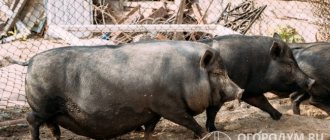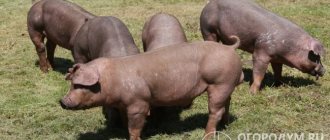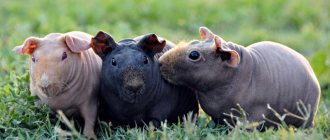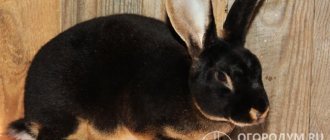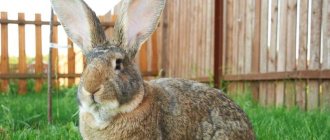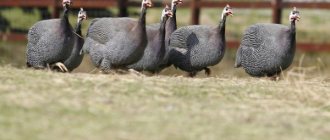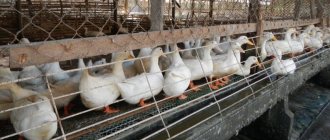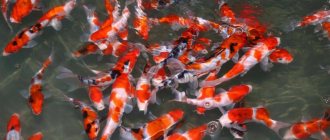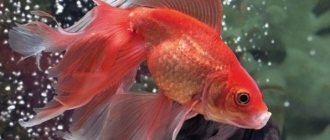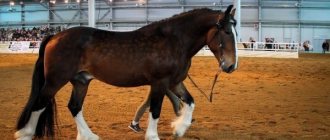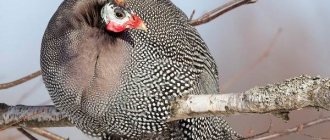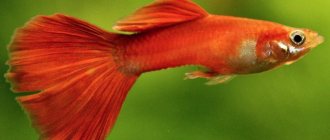History of the breed
The name of the breed is the result of a historical error. Vietnamese pigs were developed in Southeast Asia. But they came to Europe from Vietnam in 1985, which is why the breed began to be called Vietnamese. Vietnamese pigs were recently brought to Russia.
The work to improve the breed is not finished. It is especially active in Ukraine, Hungary and Canada.
The full correct name of the breed is Asian herbivorous pot-bellied pig.
Many people confuse representatives of this species with Korean pigs, or believe that Vietnamese and Chinese are the same animals. In fact, Chinese pigs are popular decorative mini pigs. Despite the huge external differences, they are truly related to the Vietnamese pot-bellied.
Photo gallery
Photo 1. Two black pot-bellied pigs
Photo 2. Sows and newborn piglets
Photo. Vietnamese pigs with their owner
Description and characteristics of Vietnamese pigs
Vietnamese pigs are large animals. As an adult, an individual should weigh from 80 to 100 kilograms. Breeding representatives of the breed can weigh up to 150 kilograms. A pig gains weight during the first 5 years of life at a high rate. But gradually this process is slowing down. In wild boars, the fangs begin to grow at 6 months, and reach 10-15 centimeters.
Representatives of this breed do not differ in color variations. They can be:
- black (mostly common color);
- black and white.
A noticeable external difference between the Vietnamese breed and others is the drooping belly. It appears from the first month of life.
In terms of body structure, the animals are short, have short, even, strong legs, broad shoulders and chest, a large head with small erect ears, a flattened muzzle, and a snout with folds.
Sales
To search for distribution channels, you need to decide on the direction of the pig farm’s work. It can specialize exclusively in the production of meat products and the sale of piglets for further feeding. It is also possible to sell live weight pigs, raise breeding animals for sale and subsequent breeding.
Pork for sale
Meat products, subject to a veterinary control certificate, are sold directly to the end consumer, wholesale buyers or meat processing plants. With a livestock of 100 pigs or more, it is profitable to open workshops for the production of semi-finished products.
Advantages and disadvantages of breeding Vietnamese pigs
It is not for nothing that the Vietnamese Fold is one of the most popular breeds of pigs. This was facilitated by a number of advantages:
- Rapid gain of slaughter weight. Already at 7-8 months, representatives of this breed reach 80 kilograms.
- Early puberty. Females are able to give birth at 4 months, while in wild boars the instinct to procreate awakens at six months.
- Fertility. A female can give birth to from 5 to 20 piglets, and produce offspring twice in a year.
- Ease of reproduction. Vietnamese potbellied sows are caring mothers who do not attack their piglets, unlike representatives of other breeds.
- Herbivory. This feature makes it easier for farmers to feed animals.
- High immunity. Diseases common to pigs do not affect Vietnamese potbellied pigs, so they do not need to be vaccinated.
- Memory for poisonous plants. The animal remembers which food harmed it and passes this knowledge through genes to subsequent generations.
- Cleanliness. Pigs of this breed always relieve themselves in the same place, located away from the sleeping and feeding area.
- Unpretentiousness to climatic changes. The breed easily tolerates extreme heat and cold.
- Peacefulness. Vietnamese pigs are non-aggressive, friendly, do not eat their piglets, do not bite, do not squeal, and are even capable of training.
- There is no unpleasant odor.
- Valuable meat. It is very tender and low in bad cholesterol.
The breed has few disadvantages. These include:
- Animal susceptibility to helminths.
- For Vietnamese pigs, drafts in the pigsty pose a particular danger.
How to choose piglets?
There are a number of rules by adhering to which you can purchase healthy and strong Vietnamese pot-bellied piglets:
- Buy piglets at the age of 1 month, then they will quickly and easily get used to the new environment.
- Find out from the breeder the baby's weight at birth and the dynamics of weight gain.
- Ask to see the piglet's parents; the quality of the offspring is determined by their appearance. Pay special attention to the sow, she should be thin and have sagging milk lobes. This is a sign that her piglets are about a month old.
- The cub itself should have strong legs, pronounced muscles and a sagging abdomen.
- For brood, do not purchase piglets from the same litter and from related parents. Their offspring will be sickly and abnormal.
- Pay attention to the mood of the little pigs. If they are in good health, they will wag their tails and play actively.
- When purchasing, ask the owner what kind of food he gave to the piglets. It will be possible to transfer young pigs to any other food, but gradually to avoid stool disorder.
Room
The room allocated for the construction of a pigsty must have a ventilation and heating system. The area is selected at the rate of 2 sq.m. for one pig, 3 sq.m. per boar and 4 sq.m. for a sow with a litter. Also, additional areas are allocated for feeders and drinkers, technical rooms for equipment, and automated care systems.
Note. When raising pigs for slaughter seasonally without breeding offspring, you can use pigsties without a heating system, since Vietnamese pigs easily tolerate a drop in temperature when autumn comes.
A draft is not allowed in the pigsty; the floor is covered with a wooden platform or covered with bedding. A walking area is provided directly next to the pig holding areas. Its area must be at least 100 sq.m. The entire territory is surrounded by a fence, and a swimming pool of 4 sq.m. is equipped on it. and up to 30 cm deep, sun shelters, logs or tree trunks against which pigs scratch their skin.
Conditions of detention, pigsty
Vietnamese pot-bellied pigs are unpretentious, but if you are planning a long-term breeding of this breed, then it is better to prepare carefully. To begin, build a pigsty:
- It should be strong and without cracks. It is better to make windows higher than the height of the pigs, so that air circulates, but does not blow through the animals. The optimal material for a pigsty is brick.
- It is advisable to fill the floor with concrete. This will make cleaning up after the pigs much easier.
- The pigsty is divided into pens by wooden partitions. “Flip-flops” are small in stature, so they need small sections.
- The departments have wooden flooring for sleeping.
- Heating is recommended. This breed can tolerate frosts, but will gain less weight. For the farrowing female and the offspring, low temperatures can be disastrous.
Vietnamese pigs are allowed to roam all year round. That's why they need an aviary. It should be fenced, with a canopy under which animals can hide from the heat and bad weather. It is recommended to dig in some rough logs that they will itch on and make a mud pool. Thanks to it, pigs will be able to cool down in the heat and drive away annoying insects. The water in the pool needs to be changed once a week.
Activity
Judging by the reviews, Asian pigs need to move as much and as often as possible. This is necessary so that they do not gain excess weight. A sedentary lifestyle will cause the layer of fat to increase. Therefore, it is necessary to provide them with a walking area. It should be located near the pigsty.
Within this area, dig a medium-sized hole and fill it with water. Mud baths will help pigs cool down during the hot season and ward off insects. It is necessary to provide a tree or log against which the piglets can scratch their sides and also their backs.
Feeding, products
Many inexperienced farmers, having learned that Vietnamese pot-bellied fish are herbivores, feed them with pasture alone. Pigs actually survive with this method of feeding, but the desired weight gain will not occur.
In addition to natural grazing, which guarantees fresh grass in the diet, it is worth providing “flip-flops” with:
- clover and alfalfa hay;
- fresh zucchini, pumpkin, carrots, apples;
- boiled potatoes;
- vitamin supplements.
Representatives of this breed are well fed with a grain feed mixture consisting of barley and wheat ground into flour. You can add a little legumes, oats and corn to it, but no more than 10% of the total mass. Otherwise, they will cause excess fat formation.
The taste of meat improves if pigs eat wet food. To prepare it, the grain mixture with the addition of 5-10 grams of salt is steamed with boiling water.
Sows should be given milk, eggs, whey, fish oil and vitamins. Additives are added to the cooled cereal porridge.
Vietnamese pot-bellied pigs have a small stomach and intestinal diameter, so they are not suitable for food:
- coarse feed;
- straw;
- fodder beet;
- high fiber foods;
- an abundance of corn, oats and peas in the feed.
When caring for this breed, it is necessary to regularly administer deworming medications.
Additionally, we recommend reading how to make your own feeder for pigs.
Feedback from livestock farmers
Yuri, 31 years old, Lviv region
Our people are not yet in a hurry to have Asian pigs, although they say that it is not just fashionable, but profitable. By the way, in neighboring Poland there are also very few of them, and in Hungary they are kept in almost every household. The Vietnamese are really very clean, calm, obedient and friendly. The grass is eaten both fresh and dry. If grazing is possible, they can produce good growth on pasture. And if you feed them with steamed feed, they will get fat right before your eyes.
Sergey, 46 years old, Usman
I raised my first Vietnamese dogs, they injected them today. At 8 months, the net weight was 40 kg, there was a little fat, about 2 cm. By this age, my plain white ones were already gaining about 80 kg. He fed them the same, gave the Vietnamese more grass and some oat bran, and sometimes added scraps from the kitchen. Pigs are very friendly, they wag their tail like dogs when you enter a pigsty. The main thing is that neither the floor nor the logs are chewed, and the locks on the doors are not broken. When cutting, I didn’t like that the skin was drier and rougher than white skin, and it was not very easy to clean after scorching. But the meat and lard are more tender, I liked the taste. It makes sense to breed for yourself, but not for sale.
Oleg, 52 years old, Rechitsa
Duroc meat has the best taste, while Vietnamese meat is so-so. Depends largely on the diet. This breed of pig is of interest primarily to breeders for its multiple births. Crosses with white ones, for example, grow faster and have fat.
Anna, 45 years old, Omsk region
We dry Vietnamese piglets immediately after birth, castrate the boars and bite off their upper and lower fangs with wire cutters. If the fangs are not removed, they then grow up to 15 cm in length. We do not immediately tear off the umbilical cord, but spray it with Kubatol. When it dries a little, tear it off at a distance of 7-10 cm and again spray with Kubatol. This way you don’t have to bother with thread and stop the bleeding. After 2-3 days it dries out and falls off on its own, but you need to look at it and, in some cases, treat it again. At the same time, the piglets are given vitamins and iron.
Reproduction
The most important thing in breeding pot-bellied pigs is not to let the boar cover your relative. The offspring will be sick, have poor weight gain, and may be infertile. To prevent this, you need to know the signs that a female is ready for mating:
- anxiety and nervousness;
- swelling of the genital loop;
- discharge from the genitals appears;
- freezing in place when pressure is placed on the croup.
Although females reach sexual maturity at 4 months, and in some cases earlier, they should be bred only when they gain sufficient weight - 32-35 kilograms. Otherwise, the offspring will be frail, and the sow may not tolerate pregnancy and childbirth well.
A pregnant female carries piglets for 114-118 days. During her first farrow she will give birth to about 5 babies. Then on average there are 10-12, but their number can reach 20 pieces.
5-6 days before giving birth, the female will begin to worry and make a nest out of straw or hay. If the belly has dropped and colostrum appears on the nipples, farrowing will occur in the next 10-20 hours. You need to prepare for it:
- Clean the machine and put in fresh hay.
- Fence off and insulate the area for the piglets. In the first days, babies should be kept at a temperature of at least +20 degrees Celsius, and preferably at +30-32 degrees.
- Increase the overall heating of the pigsty.
- Make sure that the female always has clean water. She will not feed on the day of birth.
Many people do not interfere with the birth process and do not touch the piglets for the first days. But this can result in the death of the cubs, especially during the female’s first farrowing. Babies are born very hungry, and if the sow does not have colostrum in advance or soon after farrowing, they may die. Therefore, you need to prepare in advance for the birth itself:
- backup option for feeding newborn piglets;
- diapers for wiping and wrapping;
- a clean flannel cloth to clear mucus from the eyes and respiratory tract;
- disinfectant (for example, chlorhexidine solution);
- scissors and thread to sew up the umbilical cord;
- iodine and cotton wool to cauterize the wound.
Childbirth in a Vietnamese sow lasts from 3 to 5 hours. The end of the process is indicated by the release of the placenta.
Staff
With a small herd of up to 10 pigs, the farmer usually manages on his own and does not need hired employees. For larger production, the number of personnel is calculated based on the proportion of 3-4 employees per 150 heads. Their responsibilities include feeding the animals, cleaning the pigsty, caring for newborn piglets and the sow. Also, the farm staff must provide a salary for a veterinarian and an accountant (the services of these specialists can be provided outside the staff, under a contract).
Raising offspring
The piglets are surrounded by the care of their mother; her milk gives them all the necessary substances for the first days of life. But strong babies can push weaker ones away from the nipples, this needs to be monitored and everyone should be helped to have access to nutrition.
There is no iron in sow milk. This often leads to anemia in piglets. Therefore, they are given injections into the muscles of iron-containing preparations for animals, the dosage and number of injections is according to the instructions.
Additives are introduced into the diet of weekly offspring:
- chalk;
- charcoal;
- calcium;
- phosphorus.
On the tenth day, they are provided with a drinking bowl with clean water; by this time, the weight of each baby should be at least 1 kilogram. On the twentieth day, porridge from mixed feed with vitamins is introduced into the diet. A one-month-old piglet is already fed adult food. At this age he weighs 3 kilograms and can be sold.
Weaning should not be done one day, but gradually, offering babies an alternative to milk. Otherwise, the piglets will have a nutritional disorder, and the sow will have mastitis.
At the age of 40 days, anthelmintic procedures can be performed on piglets. For example, give the drug Brovadazole.
Nutrition
According to reviews, representatives of the Vietnamese breed are very picky about food. They don't eat everything that comes their way. Piglets, as a rule, do not taste poisonous plants or strange or spoiled foods. However, you should watch what pigs eat, because an incorrect diet can lead to excess weight gain and an increase in the layer of lard.
Feeding pot-bellied Vietnamese piglets, as experts advise, should be done twice a day in the summer. If they graze and have free access to fresh grass, then it is enough to simply feed the animals with grains, vegetables and fruits. Feeding pot-bellied Vietnamese piglets in winter is carried out three times a day. Feeding during this period includes beets, pumpkins and carrots.
Breeding Vietnamese pigs as a business
The cost of a Vietnamese pot-bellied piglet is 3,000 rubles, and an adult piglet is 8,000 rubles. For breeding, it is enough to buy 2 females and 1 boar.
Housing conditions and feeding of this breed do not require large investments. As a result, all costs will be recouped within one year.
The nutritional properties and low content of bad cholesterol, rare for pork meat, make Vietnamese pot-bellied pigs unique, which increases their value. They are in high demand at farmers' and food markets.
At meat markets, the meat of young teenage pigs is especially valued. But more often adult animals weighing 80-100 kg are sent to slaughter.
You can learn more about keeping, feeding and breeding Vietnamese pot-bellied pigs by watching this video:
At the moment, the Vietnamese pot-bellied pig is the most profitable for home breeding. She grows quickly, produces large offspring, has high immunity, and an easy-going character. Its meat differs from the meat of other pig breeds in that it has more beneficial characteristics. The costs of keeping the animals are minimal and are fully covered by the sale of the first farrow.
0
0
Copy link
Health
Asian pigs have some health characteristics that you need to consider before breeding these animals. Note that their immunity is very good. They are almost not susceptible to various diseases.
The disease that most often affects these animals is helminth infection. However, this can be avoided if you monitor hygiene in the places where they are bred, and also take preventive measures where Vietnamese pot-bellied piglets live. They hardly need vaccinations. At least in large quantities. Deworming should be carried out regularly not only to protect the pigs, but also to protect yourself, since worms in piglets can be very dangerous to humans.
Another problem is the reaction of the piglets’ body to drafts. Small pigs are susceptible to strong gusts of wind, which can cause them to suffer from colds.
